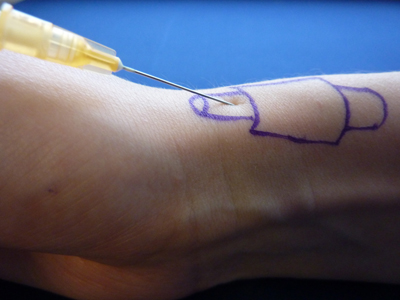DeQuervains Injection
As a treatment where significant symptoms.
For symptom control prior to surgery DeQuervains post pregnancy.
DeQuervains with marked symptoms after prolonged strenuous or unaccustomed activity.
One injection permanently relieves symptoms in roughly 50% of patients. A second injection given at least a month later permanently relieves symptoms in another 40-45% of patients.
When to avoid injection
- If two injections have failed to relieve symptoms
- If there is significant tendon damage
- Local or systemic infection
Risks and complications
Infection – very rare probably 1 in 15000
Skin depigmentation, dermal atrophy, adipose atrophy, particularly if injection too superficial
Tendon rupture – very rare in non-rheumatoid patients
Flare of symptoms
Increased blood sugars in diabetic patients, this may last for 3-7 days with significant elevation of blood sugars
Facial flushing particularly in ladies
Equipment
Antiseptic spray ( alcoholic chlorhexidine), dressings/ adhesive plaster for after injection, gloves.
5ml of 1 or 2 % lidocaine, 5 ml syringe, drawing up needle.
Long orange needle 25mm, 25 guage
10- 20mg of triamcinolone or Kenalog in a separate 1ml syringe
Positioning
How patients are positioned during the procedure
The patient is seated, and the affected hand in mid pro-supination with the thumb facing the ceiling on a table or other flat surface.
The patient is asked to move the thumb up and down so that the Abductor Pollicis Longus (APL) Tendon can be identified as it courses over the radial styloid, in line with the thumb, This is vitally important to ensure accurate placement of the injection. The course of the tendon may be marked with a pen for approximately 2-3 cm proximally prior to antiseptic spray application.
Where to inject
After antiseptic application and under strict aseptic technique.
With the local anaesthetic first and the orange needle , at 45 degrees to the skin, entry point just proximal to the radial styloid angled proximally towards the elbow. Slowly advance the needle in line with the APL tendon, injecting small amounts of local anaesthetic so as to avoid obscuring the anatomy. Avoid injecting into the terminal branches of the superficial branches of the radial nerve.
Infiltrate skin, subcutaneous tissue, feel the needle pass through the flexor sheath then abduct and flex the finger to ensure the needle is within the APL tendon. With draw the needle slightly but remain in the tendon sheath. Continue injecting local anaesthetic, this should flow reasonable freely and be seen filling the sheath up and not causing a localised subcutaneous swelling. Change the syringe, inject 10-20 mg of steroid. Injecting in 2-4 separate sites along the sheath may be more efficacious.
Apply pressure for 5 minutes then a light dressing. Advise the patient to be cautious with use of the hand over the next day. Expect some discomfort for a day or two.
Pearls
Caution should be exercised to ensure that the injection is placed in the sheath rather than subcutaneously, where corticosteroids can lead to fat and dermal atrophy. Atrophy causes a hollowing-out of the skin and a loss of normal pigmentation. Although these atrophic changes generally resolve over 6 months, their presence is disturbing to most patients.
In our clinical practice we see fat and dermal atrophy most often following injections for DeQuervains.
To avoid potential complications of vascular or nerve ischemia, tissue necrosis, and serious damage to nerve, lidocaine with adrenaline
should not be used.


